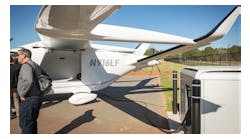Since the inception of the Federal Aviation Administration’s Runway Incursion Mitigation (RIM) program in June 2015, many airports are engaging in extensive studies to make their airfields and surrounding areas safer for everyone. The intent is to keep improving a system that has already achieved a remarkable safety record.
Many airports are partnering with organizations such as HNTB Corporation to take a more holistic approach to assessing airfield-wide safety issues. One major focus of these RIM studies is airfield geometry, which has been identified as a primary contributing factor for runway incursions, which involve aircraft, vehicles, or pedestrians on a portion of the airfield when they should not be. RIM aims to reduce the risk severity and likelihood of an incursion to occur.
How to prepare
The Airports Council International-North America expects most commercial-service U.S. airports will receive RIM-related recommendations from the FAA. To prepare, take these proactive steps:
- Conduct an in-house assessment of potential problems
- Identify incursion risk likelihood and severity
- Identify mitigation options (geometry, marking, signage, lighting, procedural, education)
- Document any constraints and how they impact or limit mitigation
- Understand operational consequences — both positive and negative
- Collaborate with stakeholders including airport sponsors, flight operators, and FAA
The Long Beach Airport study
HNTB’s proven methodology for completing RIM analysis comes from its experience assisting multiple airports with airfield geometry studies, including Long Beach Airport, Tucson International Airport, Boston Logan International, Phoenix Sky Harbor International, Los Angeles International, and Detroit Metropolitan.
The Long Beach Airport study took an in-depth look at the layouts of runways and taxiways to identify mitigation actions in concordance with FAA regulations, such as education, markings, lighting, and geometry. In addition to reviewing the detailed analysis, stakeholders held an informal panel to assess hot spots that contained the highest risk of potential surface incidents and runway incursions at the airport. Geometric recommendations from the study led the Long Beach Airport to adjust some of the configurations of its taxiways and runways to improve airfield safety.
Risk factors and the balancing act
It is a delicate balancing act to improve the safety of airfields while maintaining efficiency. HNTB’s holistic approach considers how each mitigation strategy will affect operations upstream and downstream of the proposed update as well as stakeholder needs and local conditions.
While RIM studies and improvements are necessary to accommodate the increasing traffic in our nation’s airports, some airports are concerned that the recommendations that focus on improving airfield safety will have a negative effect on airfield capacity and efficiency.
An airport could experience an inverse relationship between safety and efficiency if it attempts to correct hot spots in a vacuum - that is, isolating and addressing each incursion area without considering how the solution would affect other areas on the airfield.
As an example, reconfiguration that makes it more difficult for an aircraft to errantly enter onto a runway also could make it difficult for aircraft to quickly exit the runway, creating delays and possible additional incursions. So how can we balance the needs of both safety and efficiency?
From extensive experience aiding airports across the country, HNTB has developed several best practices to aid airports each step of the way:
- Insist on a transparent stakeholder engagement process. This is the single most important element to ensuring that the study will be successful. Invite all stakeholders to the planning table, including regulators, users, elected officials and airport authority owners. It is also important to recognize these groups will have opinions about how the airfield should change, if it should change and why. Once their participation is secured, continued communication is important. Explain the process and ask for their help in developing a hierarchy of criteria for the project.
- Understand (and expect) stakeholder nuances. The FAA funds a majority of the project, so it naturally has a vested interest in the study. Even within the one FAA entity, however, differences of opinion will occur. Take, for example, the FAA’s Airports Division, which is charged with implementing RIM, but in applying RIM criteria, the airport may find the Air Traffic Organization pushing back because of the way the proposed changes impact airfield operations. The sponsor can achieve a common vision for success among the FAA’s various lines of business by engaging these stakeholders early in the process.
- Consider future operation and traffic levels. Simulate current and future airfield conditions under a variety of traffic levels. Simulation tests multiple mitigation strategies and quantifies the positive and negative impacts using parameters such as delay and travel time.
- Use clear, easy-to-interpret graphics. Visuals, including animations from simulations, help clearly communicate your goals and design plans to technical and non-technical audiences.
- Utilize risk-based decision-making. The FAA is moving to risk-based decision-making for acceptance of proposed improvements to the airfield. Under a risk-based approach, not all hot spots or non-conforming geometry may need to be addressed, which can save time and money in implementing the recommendations.
- Be involved. Active owner participation results in fewer surprises, better documentation and a successful, lasting outcome.
- Seek opportunities. Airfield geometry studies can be executed as stand-alone projects (Long Beach Airport), runway design projects (Los Angeles International) or part of a master plan update (Detroit Metropolitan Airport, Phoenix Deer Valley Airport). They don’t have to be pigeonholed solely as a planning activity.
Because the FAA provides a large percentage of the funds for a master plan update, it can be economical for an airport to assess RIM criteria as part of a typical airside analysis component of a master plan.
By following the suggested best practices and maintaining clear communication with all invested parties throughout the process, airports can reduce hot spots in their airfields and increase the safety of the U.S. aviation system. Additionally, they do not have to sacrifice efficiency for safety when mitigating runway incursions by using this holistic approach.
Greg Albjerg, PE is the national aviation planning director for HNTB. He is a registered professional civil engineer and an active, licensed pilot with instrument rating. Albjerg has three years of experience as an air traffic controller with the Federal Aviation Administration. He has been directly involved in a wide variety of airport engineering, planning and environmental projects, ranging from small general aviation airports to major air carrier airports.
Justin Bychek, PE is a senior aviation planner for HNTB and has been involved in a wide variety of airport planning projects at more than 30 airports across the country. His broad expertise includes preparing RIM studies, airfield capacity and efficiency planning, data analysis, ALPs, and airfield and airspace simulation/interaction. He has been a leader and on the forefront of the FAA’s RIM program.




